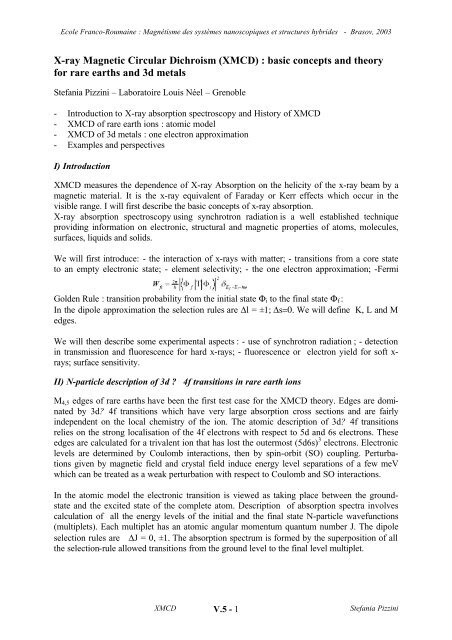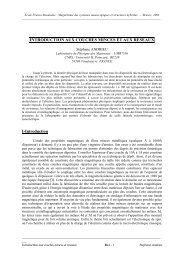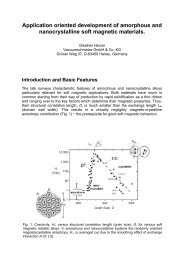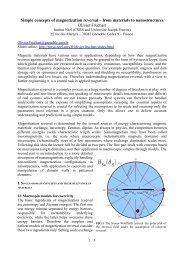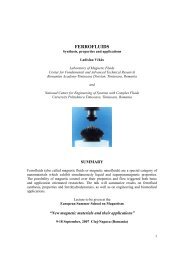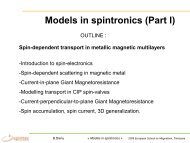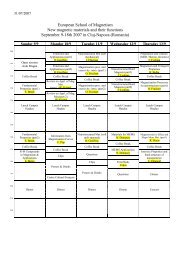X-ray Magnetic Circular Dichroism (XMCD) : basic concepts and ...
X-ray Magnetic Circular Dichroism (XMCD) : basic concepts and ...
X-ray Magnetic Circular Dichroism (XMCD) : basic concepts and ...
Create successful ePaper yourself
Turn your PDF publications into a flip-book with our unique Google optimized e-Paper software.
Ecole Franco-Roumaine : Magnétisme des systèmes nanoscopiques et structures hybrides - Brasov, 2003<br />
X-<strong>ray</strong> <strong>Magnetic</strong> <strong>Circular</strong> <strong>Dichroism</strong> (<strong>XMCD</strong>) : <strong>basic</strong> <strong>concepts</strong> <strong>and</strong> theory<br />
for rare earths <strong>and</strong> 3d metals<br />
Stefania Pizzini – Laboratoire Louis Néel – Grenoble<br />
- Introduction to X-<strong>ray</strong> absorption spectroscopy <strong>and</strong> History of <strong>XMCD</strong><br />
- <strong>XMCD</strong> of rare earth ions : atomic model<br />
- <strong>XMCD</strong> of 3d metals : one electron approximation<br />
- Examples <strong>and</strong> perspectives<br />
I) Introduction<br />
<strong>XMCD</strong> measures the dependence of X-<strong>ray</strong> Absorption on the helicity of the x-<strong>ray</strong> beam by a<br />
magnetic material. It is the x-<strong>ray</strong> equivalent of Faraday or Kerr effects which occur in the<br />
visible range. I will first describe the <strong>basic</strong> <strong>concepts</strong> of x-<strong>ray</strong> absorption.<br />
X-<strong>ray</strong> absorption spectroscopy using synchrotron radiation is a well established technique<br />
providing information on electronic, structural <strong>and</strong> magnetic properties of atoms, molecules,<br />
surfaces, liquids <strong>and</strong> solids.<br />
We will first introduce: - the interaction of x-<strong>ray</strong>s with matter; - transitions from a core state<br />
to an empty electronic state; - element selectivity; - the one electron approximation; -Fermi<br />
Golden Rule : transition probability from the initial state Φ i to the final state Φ f :<br />
In the dipole approximation the selection rules are ∆l = ±1; ∆s=0. We will define K, L <strong>and</strong> M<br />
edges.<br />
We will then describe some experimental aspects : - use of synchrotron radiation ; - detection<br />
in transmission <strong>and</strong> fluorescence for hard x-<strong>ray</strong>s; - fluorescence or electron yield for soft x-<br />
<strong>ray</strong>s; surface sensitivity.<br />
II) N-particle description of 3d 4f transitions in rare earth ions<br />
M 4,5 edges of rare earths have been the first test case for the <strong>XMCD</strong> theory. Edges are dominated<br />
by 3d 4f transitions which have very large absorption cross sections <strong>and</strong> are fairly<br />
independent on the local chemistry of the ion. The atomic description of 3d 4f transitions<br />
relies on the strong localisation of the 4f electrons with respect to 5d <strong>and</strong> 6s electrons. These<br />
edges are calculated for a trivalent ion that has lost the outermost (5d6s) 3 electrons. Electronic<br />
levels are determined by Coulomb interactions, then by spin-orbit (SO) coupling. Perturbations<br />
given by magnetic field <strong>and</strong> crystal field induce energy level separations of a few meV<br />
which can be treated as a weak perturbation with respect to Coulomb <strong>and</strong> SO interactions.<br />
In the atomic model the electronic transition is viewed as taking place between the groundstate<br />
<strong>and</strong> the excited state of the complete atom. Description of absorption spectra involves<br />
calculation of all the energy levels of the initial <strong>and</strong> the final state N-particle wavefunctions<br />
(multiplets). Each multiplet has an atomic angular momentum quantum number J. The dipole<br />
selection rules are ∆J = 0, ±1. The absorption spectrum is formed by the superposition of all<br />
the selection-rule allowed transitions from the ground level to the final level multiplet.<br />
<strong>XMCD</strong><br />
V.5 - 1<br />
Stefania Pizzini
Ecole Franco-Roumaine : Magnétisme des systèmes nanoscopiques et structures hybrides - Brasov, 2003<br />
Almost perfect agreement between calculated <strong>and</strong> experimental spectra is obtained for absorption<br />
<strong>and</strong> <strong>XMCD</strong> spectra. <strong>XMCD</strong> is the difference between the ∆M = +1 (left circular polarisation<br />
– LCP) <strong>and</strong> the ∆M=-1 (right circular polarisation – RCP) transitions.<br />
<strong>Magnetic</strong> circular dichroism is the absorption counterpart of Zeeman effect. The most convenient<br />
geometry for magnetic dichroism is that wherein a right or left circularly polarised x-<strong>ray</strong><br />
beam travels along the direction of the magnetic field.<br />
Energy diagram of the 3d 10 4f 13 3d 9 f 14<br />
transition of Yb 3+ without <strong>and</strong> with magnetic<br />
field. The arrows indicate the dipole selection<br />
rule allowed transitions from J to J’. Their<br />
relative intensities are given by the dots.<br />
Let us consider the easiest example of a trivalent Yb ion. In the field-free ion the spin orbit<br />
interaction leads to splitting of the initial state into 2 F 7/2 <strong>and</strong> 2 F 5/2 <strong>and</strong> of the final state into<br />
2 D 5/2 <strong>and</strong> 2 D 3/2 . The 2 F 7/2 multiplet is the Hund’s rule ground state. The only allowed transition<br />
is 2 F 7/2 to 2 D 5/2 with ∆J = -1, while the transition to 2 D 3/2 which would constitute the M 4 line,<br />
is dipole forbidden. Top panel of the figure below: M 5 (left) <strong>and</strong> M 4 line (right).<br />
M 5 M 4<br />
When the spherical symmetry is broken by a magnetic<br />
field the ∆J = -1 line is split into 18 lines divided over three<br />
groups with different ∆M : ∆M = 0 for parallel linearly polarised<br />
light, ∆M = ±1 for left <strong>and</strong> right circular polarisation<br />
(figure above).<br />
At sufficiently high temperature all the levels remain<br />
populated <strong>and</strong> the splitting has no effect on the spectrum.<br />
However when the magnetic field splitting gµH is large relative<br />
to thermal energy kT the upper levels are less occupied,<br />
according to Boltzman statistics, <strong>and</strong> this has an effect on the<br />
observed cross section. In the limit of 0 K only the lowest<br />
level is occupied <strong>and</strong> the transition will occur only if the light<br />
is left circularly polarised. The second panel shows the 0 K<br />
spectrum for parallel (dash) <strong>and</strong> perpendicular (dots) linear<br />
polarisation ; the third panel the difference between left<br />
(dash) <strong>and</strong> right (dots) circular polarisation ; the fourth panel<br />
gives the linear dichroism (XMLD - dash) <strong>and</strong> the circular<br />
magnetic dichroism (<strong>XMCD</strong> - dots).<br />
<strong>XMCD</strong><br />
V.5 - 2<br />
Stefania Pizzini
Ecole Franco-Roumaine : Magnétisme des systèmes nanoscopiques et structures hybrides - Brasov, 2003<br />
More complicated absorption <strong>and</strong> <strong>XMCD</strong> spectra are obtained for the other rare earths<br />
whose outer shell has more than one f electron or hole <strong>and</strong> where more transitions are allowed;<br />
some examples will be given in the course.<br />
REFERENCES<br />
B.T. Thole, G. van der Laan <strong>and</strong> G. A. Sawatzky, Phys. Rev. Lett. 55, 2086 (1985).<br />
B.T. Thole, G. van der Laan <strong>and</strong> P.H. Butler, Chem. Phys. Lett. 149, 295 (1988).<br />
G. van der Laan <strong>and</strong> B.T. Thole, Phys. Rev. B 43, 13401 (1991).<br />
G. van der Laan, B.T. Thole, G.A. Sawatzky, J.B. Goedkoop, J.C. Fuggle, J.-M. Esteva, R.C. Karnatak, J.P.<br />
Remeika <strong>and</strong> H.A. Dubkowska, Phys.Rev.B 34, 6529 (1986).<br />
B.T.Thole, G. van der Laan, J.C.Fuggle, G.A.Sawatzky, R.C.Karnatak <strong>and</strong> J.-M.Esteva, Phys.Rev.B 32, 5107<br />
(1985).<br />
J.B.Goedkoop, B.T.Thole, G. van der Laan, G.A.Sawatzky, F.M.F. de Groot <strong>and</strong> J.C.Fuggle, Phys.Rev.B 37,<br />
2086 (1988).<br />
M.Sacchi <strong>and</strong> J.Vogel, in Magnetism <strong>and</strong> Synchrotron Radiation, Lecture Notes in Physics, Vol.565, 87,<br />
E.Beaurepaire, F.Scheurer, G.Krill, J.P.Kappler (Eds.), Springer Verlag, 2001.<br />
III) <strong>XMCD</strong> in 3d metal systems<br />
<strong>Magnetic</strong> properties of transition metals are mostly due to their d electrons. We are therefore<br />
interested in exciting p core electrons i.e. to use p d dipole transitions (L 2,3 absorption<br />
edges). B<strong>and</strong> structure effects play an important role in the shape of the absorption spectra of<br />
3d transition metals. A one electron approach is generally used to treat the excitations: the<br />
electron is excited from the spin-orbit split 2p 3/2 <strong>and</strong> 2p 1/2 levels to empty d valence states.<br />
The two-step model :<br />
The two-step model proposed by Stöhr <strong>and</strong> Wu will be introduced to illustrate the origin of<br />
circular x-<strong>ray</strong> dichroism at the L 2,3 edges of 3d transition metals. Spin-orbit interaction is<br />
taken into account in the initial p-state ; the 3d b<strong>and</strong> is exchange split into spin-up <strong>and</strong> spindown<br />
b<strong>and</strong>s. In the first step, the interaction of circularly polarised x-<strong>ray</strong>s with the p shell<br />
leads to the excitation of spin-polarised electrons. The core shell can therefore be viewed as<br />
an atom-specific, localised “source” of spin-polarised electrons. The spin-polarisation depends<br />
on the edge <strong>and</strong> on the polarisation of the light. It will be demonstrated that at the L 2<br />
<strong>XMCD</strong><br />
V.5 - 3<br />
Stefania Pizzini
Ecole Franco-Roumaine : Magnétisme des systèmes nanoscopiques et structures hybrides - Brasov, 2003<br />
edge left circular polarisation (LCP) excites 25% spin up <strong>and</strong> 75% spin down electrons.<br />
Right circular polarised light does the opposite. At the L 3 edge, 62.5% (37.5%) spin up <strong>and</strong><br />
37.5% (62.5%) spin down electrons are excited by LCP (RCP) light. In a non magnetic material<br />
the total (spin-up plus spin-down ) transition intensities are the same for LCP <strong>and</strong> RCP<br />
light; as soon as there is an unbalance in the number of available empty spin up <strong>and</strong> down<br />
states (ferro-, para- or ferrimagnetic material) the absorption of the two polarisations will be<br />
different, with a difference which is opposite at the L 2 <strong>and</strong> L 3 edges. We can then visualize a<br />
second step in which the spin-polarised electrons are analysed by a spin-resolving detector<br />
consisting of the exchange split d final state.<br />
For a complete relativistic description of x-<strong>ray</strong> dichroism in the one-electron model, spin-orbit<br />
coupling has to be included also in the d-b<strong>and</strong>. The results on the <strong>XMCD</strong> signal will be<br />
shown. Many body effects are also important <strong>and</strong> some examples will be illustrated.<br />
The sum rules of <strong>XMCD</strong> :<br />
Sum rules developed by Theo Thole et al. at the beginning of the 1990’s allow the experimental<br />
integrated intensities of XAS <strong>and</strong> <strong>XMCD</strong> spectra to be related to the ground-state expectation<br />
values of the orbital <strong>and</strong> spin magnetic moments of the absorbing atom. The<br />
sum rules have been at the origin of a strong development of <strong>XMCD</strong>, which has become a<br />
reference technique for the study of magnetic properties of thin metallic films <strong>and</strong> multilayers.<br />
These equations, their validity <strong>and</strong> applicability will be discussed in the lesson.<br />
REFERENCES<br />
C.T.Chen, F.Sette, Y.Ma, <strong>and</strong> S.Modesti, Phys.Rev.B 42, 7262 (1990).<br />
N.V.Smith, C.T.Chen, F.Sette, <strong>and</strong> L.F.Mattheis, Phys.Rev.B 46, 1023 (1991).<br />
J.Stöhr <strong>and</strong> Y.Wu, in "New Directions in Research with Third-Generation Soft X-Ray Synchrotron Radiation<br />
Sources", NATO ASI Series, Series E: Applied Sciences - Vol. 254, Eds. A.S.Schlachter <strong>and</strong> F.J.Wuilleumier,<br />
pag. 221-250 (1994)<br />
H.A.Bethe <strong>and</strong> E.E.Salpeter, Quantum Mechanics of One- <strong>and</strong> Two-Electron Atoms (Plenum, New York, 1977).<br />
B.T.Thole <strong>and</strong> G. van der Laan, Europhys.Lett. 4, 1083 (1987).<br />
B.T.Thole, P.Carra, F.Sette, <strong>and</strong> G. van der Laan, Phys.Rev.Lett. 68, 1943 (1992).<br />
J.Schwitalla <strong>and</strong> H.Ebert, Phys.Rev.Lett. 80, 4586 (1998).<br />
G. van der Laan, Phys.Rev.B 55, 8086 (1997).<br />
P.Carra, B.T.Thole, M.Altarelli, <strong>and</strong> X.Wang, Phys.Rev.Lett. 70, 694 (1993).<br />
M.Altarelli, Phys.Rev.B 47, 597 (1993); T.Jo, J.Phys.Soc.Jpn. 62, 1814 (1993); F.Sette, in "New Directions in<br />
Research with Third-Generation Soft X-Ray Synchrotron Radiation Sources", NATO ASI Series, Series E: Applied<br />
Sciences - Vol. 254, Eds. A.S.Schlachter <strong>and</strong> F.J.Wuilleumier, pag. 251 (1994).<br />
C.T.Chen, Y.U.Idzerda, H.-J.Lin, N.V.Smith, G.Meigs, E.Chaban, G.H.Ho, E.Pellegrin, <strong>and</strong> F.Sette,<br />
Phys.Rev.Lett. 75, 152 (1995).<br />
D.Arvanitis, M.Tischer, J.Hunter-Dunn, F.May, N.Mårtensson, K.Baberschke, Spin-orbit-influenced spectroscopies<br />
of magnetic solids p.145, (Springer Verlag, Berlin, Germany 1996).<br />
Y.Wu, J.Stöhr, B.D.Hermsmeier, M.G.Samant, <strong>and</strong> D.Weller, Phys.Rev.Lett. 69, 2307 (1992).<br />
M.Tischer, O.Hjortstam, D.Arvanitis, J.Hunter Dunn, F.May, K.Baberschke, J.Trygg, J.M.Wills, B.Johansson,<br />
<strong>and</strong> O.Eriksson, Phys.Rev.Lett. 75, 1602 (1995).<br />
J.Vogel <strong>and</strong> M.Sacchi, Phys.Rev.B 53, 3409 (1996).<br />
D.Weller, J.Stöhr, R.Nakajima, A.Carl, M.G.Samant, C.Chappert, R.Mégy, P.Beauvillain, P.Veillet, <strong>and</strong><br />
G.A.Held, Phys.Rev.Lett. 75, 3752 (1995).<br />
H.A.Dürr <strong>and</strong> G. van der Laan, Phys.Rev.B 54, R760 (1996).<br />
G. van der Laan, J.Phys.: Condens.Matter 10, 3239 (1998).<br />
R.Wu <strong>and</strong> A.J.Freeman, Phys.Rev.Lett. 73, 1994 (1994).<br />
P.Carra, H.König, B.T.Thole, <strong>and</strong> M.Altarelli, Physica B 192, 182 (1993).<br />
J.Stöhr <strong>and</strong> H.König, Phys.Rev.Lett. 75, 3748 (1995).<br />
<strong>XMCD</strong><br />
V.5 - 4<br />
Stefania Pizzini
Ecole Franco-Roumaine : Magnétisme des systèmes nanoscopiques et structures hybrides - Brasov, 2003<br />
G. van der Laan, Phys.Rev.Lett. 82, 640 (1999).<br />
R.Wu, D.Wang, <strong>and</strong> A.J.Freeman, Phys.Rev.Lett. 71, 3581 (1993).<br />
B.T.Thole <strong>and</strong> G.van der Laan, Phys.Rev.B 38, 3158 (1988).<br />
J.Vogel <strong>and</strong> M.Sacchi, Phys.Rev.B 49, 3230 (1994).<br />
R.Nakajima, J.Stöhr, <strong>and</strong> Y.U.Idzerda, Pys.Rev.B 59, 6421 (1999).<br />
IV) Some examples of applications of <strong>XMCD</strong><br />
In the second part of the course I will give some examples of the application of <strong>XMCD</strong> to the<br />
study of element selective magnetic properties of thin films. Some of the examples are taken<br />
from the work of the group « dichroism » at the Laboratoire Louis Néel in Grenoble.<br />
I will also talk about the future perspectives of <strong>XMCD</strong> <strong>and</strong> X-PEEM, <strong>and</strong> in particular of the<br />
use of the time structure of synchrotron radiation for the use for magnetisation dynamics at<br />
sub-nanosecond timescales.<br />
S. Pizzini, A. Fontaine et al. ’Evidence of the spin-polarisation of copper in Co/Cu <strong>and</strong> Fe/Cu multilayers’, Phys<br />
Rev. Lett. 74 (1995) 1470<br />
C. Bordel, S. Pizzini et al. ‘Microscopic origin of the macroscopic magnetic properties of TbFeCoN amorphous<br />
thin films’ Phys. Rev. B 56 (1997) 8149<br />
D. Weller, J. Stohr, et al. ‘Microscopic origin of magnetic anisotropy in Au/Co/Au probed with x-<strong>ray</strong> magnetic<br />
circular dichroism’ Phys. Rev. Lett. 75 (1995) 3752<br />
M. Bonfim et al. ‘Element selective nanosecond magnetisation dynamics in magnetic heterostructures’, Phys.<br />
Rev. Lett. 86 (2001) 3646<br />
P. Gambardella, et al. ‘Giant magnetic anisotropy of single cobalt atoms <strong>and</strong> nanoparticles’ Science 300 (2003)<br />
5622.<br />
J.Vogel et al., “Structure <strong>and</strong> magnetism of Pd in Pd/Fe multilayers studied by <strong>XMCD</strong> at the Pd L 2,3 edges”,<br />
Phys.Rev.B 55, 3663 (1997).<br />
S.S.Dhesi et al., “Anisotropic spin-orbit coupling <strong>and</strong> magnetocrystalline anisotropy in vicinal Co films”,<br />
Phys.Rev.Lett. 87, 067201 (2001).<br />
<strong>XMCD</strong><br />
V.5 - 5<br />
Stefania Pizzini


